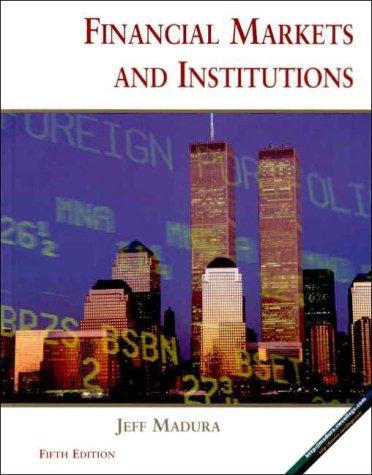Question
Circle the letter for each question / statement for the correct choice as your answer. 1. The exchange rate for delivery at some agreed upon
Circle the letter for each question / statement for the correct choice as your answer.
1. The exchange rate for delivery at some agreed upon future date from the day of the negotiated transaction is called:
a. Pegged exchange rate
b. Direct quotation exchange rate
c. Future exchange rate
d. Forward exchange rate
e. Cross exchange rate
2. Everything else equal or fixed, increase in the demand for funds (money) has an immediate effect on:
a. Increasing exchange rates
b. Increasing interest rates
c. Decreasing exchange rates
d. Improving the stock market conditions
e. Decreasing interest rates
3. The portion of nominal interest rate that represents compensation for the possibility of non repayment of the borrowed funds is termed as:
a. Taxability risk premium
b. Liquidity risk premium
c. Market risk premium
d. Default risk premium
e. Inflation risk premium
4. Which one of the following financial institutions that acts as security underwriters and consultants, technical and financial consultants in case of mergers and acquisitions, manages IPOs, and acts as wholesalers in attracting and distibuting capital:
a. Finance companies
b. Commercial Banks
c. Investment Banks
d. Mutual Funds
e. Mortgage companies or banks
5. The Fisher Effect is a theory which measures:
a. The national per capita income with a given inflation rate in a country
b. The money supply controlled by the Central Bank of a particular country
c. The relationships between nominal rate, real rate of interest and inflation rate
d. The velocity of money in the economy in the economy of a particular country
e. The effect of a systematc risk on the comon stock of a multinational firm
6. Which one of the following stock markets is located in Paris France?
a. IBEX 35
b. CAC 40
c. XEXTRA DAX 30
d. BOVESPA
e. SMI 400
7. IBM Company buys $ 50 million of Intel Companys common stock in the financial markets for its equity portfolio. What kind of market transaction is it ?
a. Bond market transaction
b. Secondary market transaction
c. Primary market transaction
d. Derivative market, swap transaction
e. Overthe-Counter market trandsaction
8. A financial contract that gives the holder the right but not the obligation, to buy or sell the underlying asset at a specified price within a specified period of time is called:
a. Forwards contract
b. Options contract
c. Swaps contract
d. Futures contract
e. Repurchase contract
9. Which one of the following is considered as a speculative credit ratings under S & P rating system?
a. CCC +
b. BBB -
c. BB +
d. Caa
e. Baa 1
10. Which one of the following statements is correct?
a. There is an upper limit for owning an equity for an investor
b. The person or firm owning a stock / share is called the creditor
c. Disadvantage of equity is double taxation but there is no direct bankruptcy risk
d. In a bankruptcy, the creditors are paid after the equity holders are paid.
e. Debt is an ownership interest in the firm and creditors have voting power
11. Which one of the following financial institutions is considered a financial regulator?
a. New York Stock Exchange
b. NASDAQ
c. Security Exchange Commission
d. Bank of America
e. Goldman Sachs
12. Which one of the following risks is the most fundamentally serious and extremely important risk that would affect an investor /entrepreneur in a business / financial
environment?
a. Market risk
b. Liquidity risk
c. Political / legal risk
d. Interest rate risk
e. Default risk
13. Which one of the following institutions is considered a Commodities Market?
a. New York Stock Exchange
b. Nikkei 225
c. NASDAQ
d. Federal Reserve System
e. Chicago Mercantile Exchange Board
14. The following derivative contract that gives the purchaser or the holder the right to buy or sell a financial instrument at a specified or a predetermined price within a specified period of time is called a (an):
a. Swap
b. Forward
c. Future
d. Option
e. Bond
15. The theory which suggests that, long run changes in the exchange rates between two countries are determined by changes in the relative price levels of the two countries
so that identical goods costs the same (law of one price) in the two countries, is called
a. Theory of Hedging
b. Theory of Arbitrage
c. Theory of International Fisher Effect
d. Theory of Purchasing Power Parity
e. Theory of Forward Exchange Rates
Step by Step Solution
There are 3 Steps involved in it
Step: 1

Get Instant Access to Expert-Tailored Solutions
See step-by-step solutions with expert insights and AI powered tools for academic success
Step: 2

Step: 3

Ace Your Homework with AI
Get the answers you need in no time with our AI-driven, step-by-step assistance
Get Started


